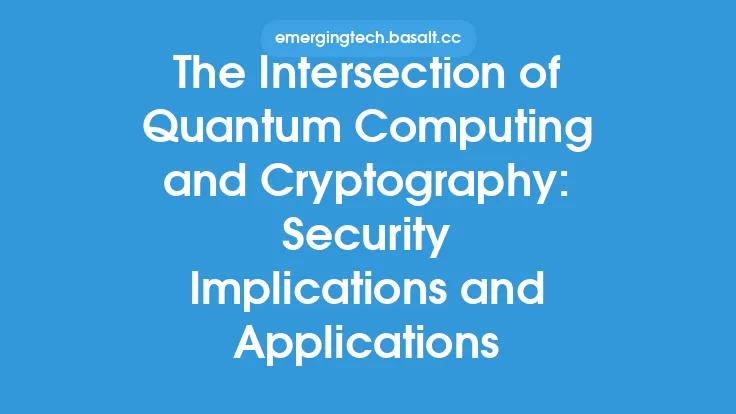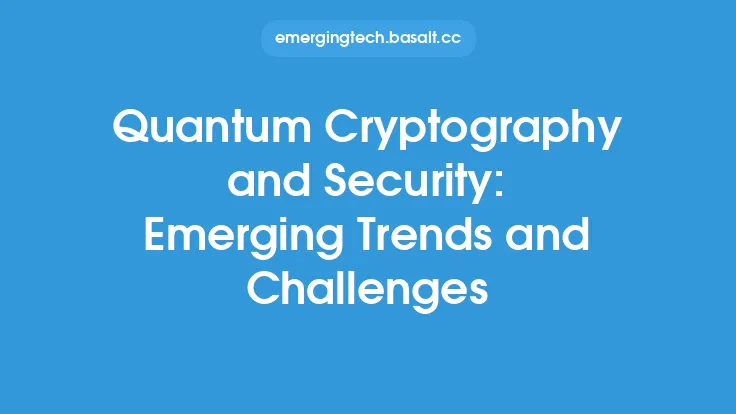The advent of quantum computing has brought about a significant shift in the way we approach cryptography and security. For decades, classical cryptographic systems have relied on the complexity of mathematical problems to ensure secure data transmission and encryption. However, the emergence of quantum computers has rendered these systems vulnerable to attack, as quantum computers can potentially solve these complex problems exponentially faster than their classical counterparts. This has led to a growing concern about the long-term security of our cryptographic systems and the need for a new generation of quantum-resistant cryptographic protocols.
Introduction to Post-Quantum Cryptography
Post-quantum cryptography refers to the development of cryptographic systems that are resistant to attacks by quantum computers. These systems are designed to be secure against both classical and quantum computers, ensuring that data remains protected even in the presence of a large-scale quantum computer. Post-quantum cryptography is not a single technique or protocol, but rather a collection of different approaches and algorithms that are designed to provide long-term security in a post-quantum world.
Types of Post-Quantum Cryptographic Algorithms
There are several types of post-quantum cryptographic algorithms, each with its own strengths and weaknesses. Some of the most popular types of post-quantum algorithms include:
- Lattice-based cryptography: This type of cryptography is based on the hardness of problems related to lattices, such as the shortest vector problem (SVP) and the learning with errors (LWE) problem. Lattice-based cryptography is considered to be one of the most promising approaches to post-quantum cryptography, as it is resistant to attacks by both classical and quantum computers.
- Code-based cryptography: This type of cryptography is based on the hardness of problems related to error-correcting codes, such as the decoding problem for Reed-Solomon codes. Code-based cryptography is another popular approach to post-quantum cryptography, as it is simple to implement and provides high security levels.
- Multivariate cryptography: This type of cryptography is based on the hardness of problems related to multivariate polynomials, such as the problem of finding a solution to a system of quadratic equations. Multivariate cryptography is considered to be a promising approach to post-quantum cryptography, as it is resistant to attacks by both classical and quantum computers.
- Hash-based signatures: This type of cryptography is based on the hardness of problems related to hash functions, such as the problem of finding a collision in a hash function. Hash-based signatures are considered to be a simple and efficient approach to post-quantum cryptography, as they are easy to implement and provide high security levels.
Key Features of Post-Quantum Cryptographic Algorithms
Post-quantum cryptographic algorithms have several key features that distinguish them from classical cryptographic algorithms. Some of the most important features of post-quantum algorithms include:
- Quantum resistance: Post-quantum algorithms are designed to be resistant to attacks by quantum computers, which means that they must be able to withstand attacks by a large-scale quantum computer.
- High security levels: Post-quantum algorithms are designed to provide high security levels, which means that they must be able to protect data against a wide range of attacks, including side-channel attacks and quantum computer attacks.
- Efficiency: Post-quantum algorithms are designed to be efficient, which means that they must be able to perform cryptographic operations quickly and with minimal computational overhead.
- Scalability: Post-quantum algorithms are designed to be scalable, which means that they must be able to handle large amounts of data and perform cryptographic operations on a large scale.
Challenges and Limitations of Post-Quantum Cryptography
While post-quantum cryptography offers a promising solution to the problem of quantum computer attacks, it also presents several challenges and limitations. Some of the most significant challenges and limitations of post-quantum cryptography include:
- Key sizes: Post-quantum algorithms often require larger key sizes than classical algorithms, which can make them more difficult to implement and manage.
- Performance: Post-quantum algorithms can be slower than classical algorithms, which can make them less suitable for high-performance applications.
- Standardization: Post-quantum cryptography is still a relatively new field, and there is a need for standardization and interoperability between different post-quantum algorithms and protocols.
- Quantum computer attacks: While post-quantum algorithms are designed to be resistant to quantum computer attacks, there is still a risk that a large-scale quantum computer could be built, which could potentially compromise the security of post-quantum systems.
Real-World Applications of Post-Quantum Cryptography
Post-quantum cryptography has a wide range of real-world applications, including:
- Secure communication protocols: Post-quantum cryptography can be used to secure communication protocols, such as SSL/TLS and IPsec, against quantum computer attacks.
- Data encryption: Post-quantum cryptography can be used to encrypt data, both in transit and at rest, against quantum computer attacks.
- Digital signatures: Post-quantum cryptography can be used to create digital signatures that are resistant to quantum computer attacks.
- Cryptocurrencies: Post-quantum cryptography can be used to secure cryptocurrencies, such as Bitcoin and Ethereum, against quantum computer attacks.
Future Directions for Post-Quantum Cryptography
The field of post-quantum cryptography is rapidly evolving, and there are several future directions that researchers and developers are exploring. Some of the most promising future directions for post-quantum cryptography include:
- Hybrid approaches: Hybrid approaches that combine different post-quantum algorithms and protocols to provide higher security levels and better performance.
- Quantum computer-aided cryptography: Quantum computer-aided cryptography that uses quantum computers to aid in the development and implementation of post-quantum cryptographic protocols.
- Post-quantum key exchange: Post-quantum key exchange protocols that are resistant to quantum computer attacks and provide high security levels.
- Quantum-resistant random number generators: Quantum-resistant random number generators that are designed to provide high-quality random numbers that are resistant to quantum computer attacks.
Conclusion
In conclusion, post-quantum cryptography is a rapidly evolving field that is critical to the long-term security of our cryptographic systems. As quantum computers become more powerful and widely available, the need for post-quantum cryptography will only continue to grow. By understanding the principles and concepts of post-quantum cryptography, we can begin to develop and implement quantum-resistant cryptographic protocols that will provide high security levels and protect our data against quantum computer attacks. While there are still challenges and limitations to overcome, the future of post-quantum cryptography is promising, and it is likely to play a critical role in the development of secure communication protocols and data encryption systems in the years to come.





